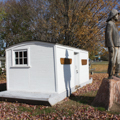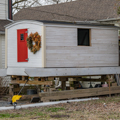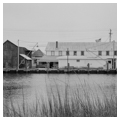Situated along the Chesapeake Bay, the world’s largest estuary, Marylanders could not help but embrace boatbuilding for both commercial and recreational purposes. Responding to the singular conditions of the Chesapeake Bay and the requirements of the fishing, crabbing, and oystering industries, Maryland boatbuilders created such distinctive sailing vessels as the log canoe, brogan, bugeye, pungey, crabbing skiff, two- and three-sail bateaux, and the fishing shanty. Also originating from broadly recognized forms are the Chesapeake schooner, sloop, skipjack, and the Baltimore Clipper. While Baltimore was internationally recognized for its commercial ships, many Chesapeake boats were built by watermen for their own use, adapted to allow passage through the Bay’s many shallow tributaries and coves.
The earliest Chesapeake boat is the log canoe, originating from Native American forms during the colonial era. Constructed from a single log, it was adaptable to many purposes, becoming the most conspicuous type found on the Chesapeake Bay. As large timbers became scarce, smaller logs were fastened together and planed smooth. First paddled, log canoes were later rigged for sailing and outfitted with a keel. Some were expanded to include decks and small cabins for longer excursions, such as the two-mast brogan, with a sharp stem and stern that made it ideal for oyster dredging. Log-built boats later took on other forms such as the bugeye and skiff. The bugeye was specifically suited to oyster dredging, embracing a more rounded stern, cabin, and two-masted sailing rig. The name may be a reference to buckie, the Scottish word for “oyster.” Skiffs were plank-built with a sharp bow and a flat bottom allowing them to negotiate the Bay’s shallower waters.
Traditional types modified by Chesapeake boatbuilders were the two-masted schooner and the single-masted, round-bottomed sloop, the oldest sailing vessel on the Bay based upon European antecedents. An important variation on the schooner was the pungey, a longer boat with a deeper stern and taller sails. The skiff and schooner were eventually superseded by the skipjack, an enlarged skiff with a nearly flat bottom that was easier and cheaper to build, and that “skipped” across the water. It quickly became the dominant large-scale sailing vessel during the early twentieth century, now used almost exclusively for oystering. The skipjack is recognized as the official state boat of Maryland. Also particular to the Chesapeake is the fishing shanty or ark (see Captain Carter’s Fishing Shanty) with a cabin that allowed fishermen overnight excursions. With the advent of motorization, local builders crafted recreational boats as well. Although many of these traditional forms are vanishing or no longer extant, significant collections are found in the Chesapeake Bay Maritime Museum, Calvert Marine Museum, and Havre de Grace Maritime Museum (100 Lafayette Street).
Writing Credits
If SAH Archipedia has been useful to you, please consider supporting it.
SAH Archipedia tells the story of the United States through its buildings, landscapes, and cities. This freely available resource empowers the public with authoritative knowledge that deepens their understanding and appreciation of the built environment. But the Society of Architectural Historians, which created SAH Archipedia with University of Virginia Press, needs your support to maintain the high-caliber research, writing, photography, cartography, editing, design, and programming that make SAH Archipedia a trusted online resource available to all who value the history of place, heritage tourism, and learning.













